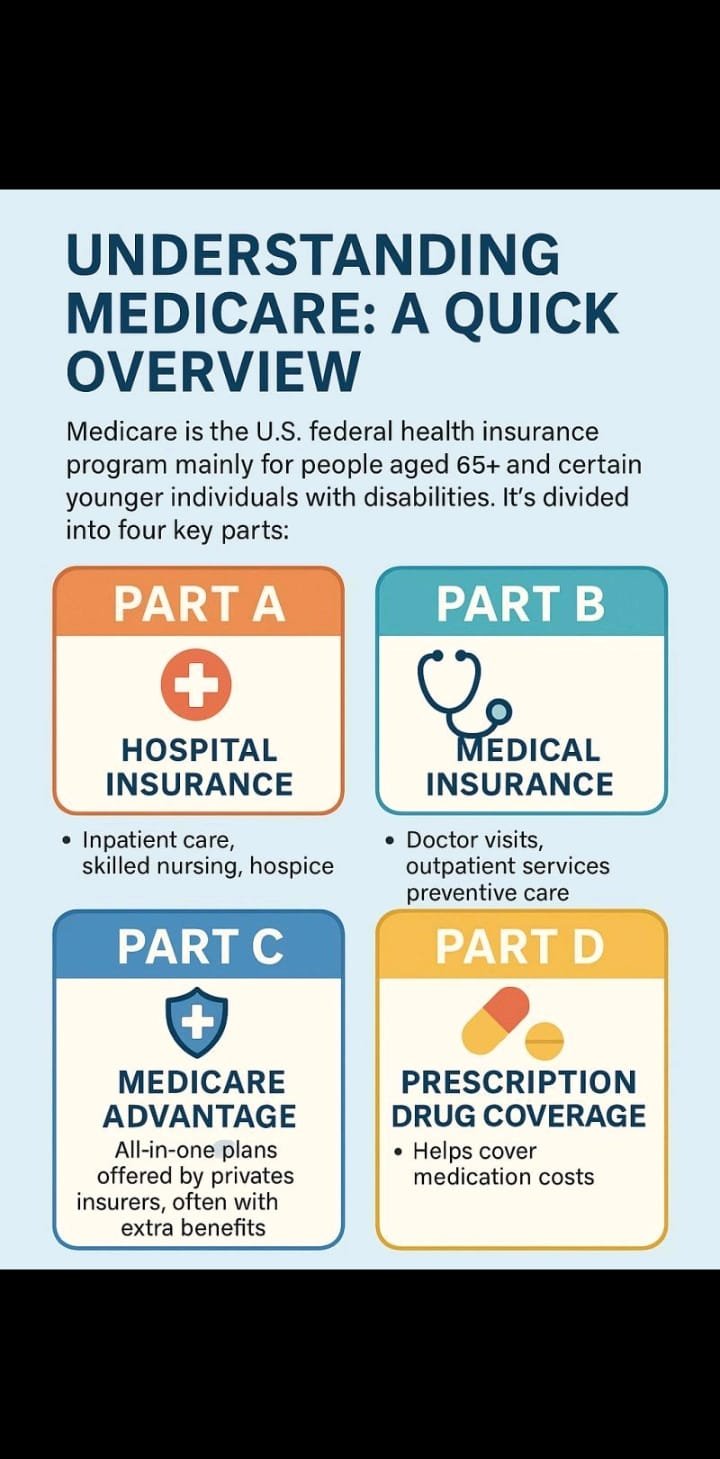Medicare is a federal health insurance program mainly for people 65 and older, and for younger individuals with disabilities or serious conditions like kidney failure. If you’re a kidney patient, understanding Medicare helps you get the care you need without surprise costs.
Here are the Medicare basics:
- Who qualifies? Adults 65+, those with End-Stage Renal Disease (ESRD), and certain disabilities
- Why it matters? Helps cover hospital stays, doctor visits, medications, and more
- When to enroll? Initial Enrollment starts 3 months before your 65th birthday
Key LSI Keywords: federal health insurance, Medicare eligibility, ESRD coverage, Medicare for kidney patients
What Are the Different Types of Medicare?
Medicare comes in different parts, each serving a specific purpose. Knowing these helps you make the best decision for your health and budget.
Main types of Medicare:
- Original Medicare (Parts A & B): Managed by the federal government, covers hospital and medical services
- Medicare Advantage (Part C): Private insurance alternative with extra benefits like vision and dental
- Prescription Drug Plans (Part D): Stand-alone plans or bundled with Advantage plans
Differentiation Chart: Medicare Types
| Type | Coverage | Provider | Extra Benefits | Best For |
|---|---|---|---|---|
| Part A | Hospital stays | Government | No | Basic hospital coverage |
| Part B | Doctor visits, tests | Government | No | Outpatient care |
| Part C (Advantage) | A + B + extras | Private insurer | Vision, dental | All-in-one plan users |
| Part D | Prescription drugs | Private insurer | No | Drug coverage only |
LSI Keywords: Medicare plan comparison, Medicare types explained, kidney care coverage, private Medicare plans
Guide to Medicare Parts A B C D
Each Medicare part covers different aspects of your care. If you’re managing a chronic condition like kidney disease, knowing what each part includes can help you save on treatment.
Medicare Parts Overview:
- Part A (Hospital Insurance): Covers hospital stays, skilled nursing, and some home health
- Part B (Medical Insurance): Covers doctor visits, outpatient services, dialysis, and preventive services
- Part C (Medicare Advantage): Combines A and B, often D, with additional benefits
- Part D (Prescription Drugs): Covers medications prescribed by your doctor
Chart: Key Features of Medicare Parts
| Medicare Part | Covers | Cost |
| A | Hospital stays, hospice, nursing | Usually free* |
| B | Doctors, labs, outpatient care | Monthly premium |
| C | A + B + D, extras | Varies by plan |
| D | Prescription drugs | Varies by plan |
*Free if you paid Medicare taxes for 10+ years.
Keywords: dialysis coverage, prescription drug help, Medicare Part B for kidney patients, hospital insurance
Benefits of Enrolling in Medicare
Enrolling in Medicare helps you avoid high medical costs and ensures you receive regular care—especially vital for people with kidney disease who need ongoing treatment.
Benefits include:
- Predictable healthcare costs
- Access to specialized kidney treatment
- Prescription drug savings
- Emergency care when needed
Key Takeaway: Medicare gives peace of mind, financial protection, and health security, especially for chronic illness management.
Keywords: Medicare advantages, ESRD benefits, dialysis cost help, chronic illness care
How Does Medicare Work with Other Insurance?
If you have other insurance like employer coverage or Medicaid, Medicare can still work with it. Coordination of benefits helps avoid duplicated coverage or gaps.
How it works:
- Primary vs. Secondary Payer: Medicare may pay first or second, depending on your other insurance
- Dual Eligibility: If you have Medicare and Medicaid, Medicaid often pays what Medicare doesn’t
- Employer Coverage: If you or a spouse are working, your employer plan may pay before Medicare
Tips for Kidney Patients: Always report other insurance to Medicare to ensure claims are processed correctly.
Keywords: Medicare coordination, dual eligibility, Medicaid with Medicare, secondary insurance
Best Medicare Advantage Plans for 2025
Medicare Advantage Plans for 2025 offer more options and better benefits for chronic care like kidney disease. Choosing the best plan means finding one with low costs, strong networks, and tailored benefits.
Top Plans for 2025 (based on features):
- UnitedHealthcare: Large network, good for dialysis coverage
- Humana: Includes fitness and wellness perks
- Aetna: Strong care coordination, good customer reviews
What to Look For:
- ESRD coverage
- Prescription drug benefits
- Specialist access
- Out-of-pocket limits
Keywords: best Medicare Advantage for kidney patients, 2025 plan comparison, dialysis-friendly plans, UnitedHealthcare, Humana, Aetna
FAQs
Q1: Can I get Medicare before age 65 if I have kidney disease?
A: Yes, if you have End-Stage Renal Disease (ESRD), you may qualify for Medicare regardless of age.
Q2: Does Medicare cover dialysis treatments?
A: Yes, Medicare Part B covers most dialysis treatments and related doctor visits.
Q3: What is the best Medicare plan if I take many prescriptions?
A: Medicare Advantage plans with drug coverage or a strong Part D plan are best for prescription needs.
Authorization In Medical Billing And Its Types
Authorization is key in healthcare. It helps patients get the care they…
Medicare and its types, Part A, Part B, Part C & Part D Services
Medicare is a federal health insurance program mainly for people 65 and…
Workers Compensation – 15K Program
When an Employee is injured at work then it is the responsibility…
What is the difference between a superbill and a charge slip?
In medical billing, understanding the tools used to document and track patient…
ICD 10 for Kidney Care: Your In-Depth Coding and Clinical Guide
Whether you’re handling billing in a nephrology clinic or navigating the world…
CPT 90471 Explained: Billing, Rules, and Reimbursement
Accurate CPT coding is the backbone of clean claims, timely reimbursement, and…

